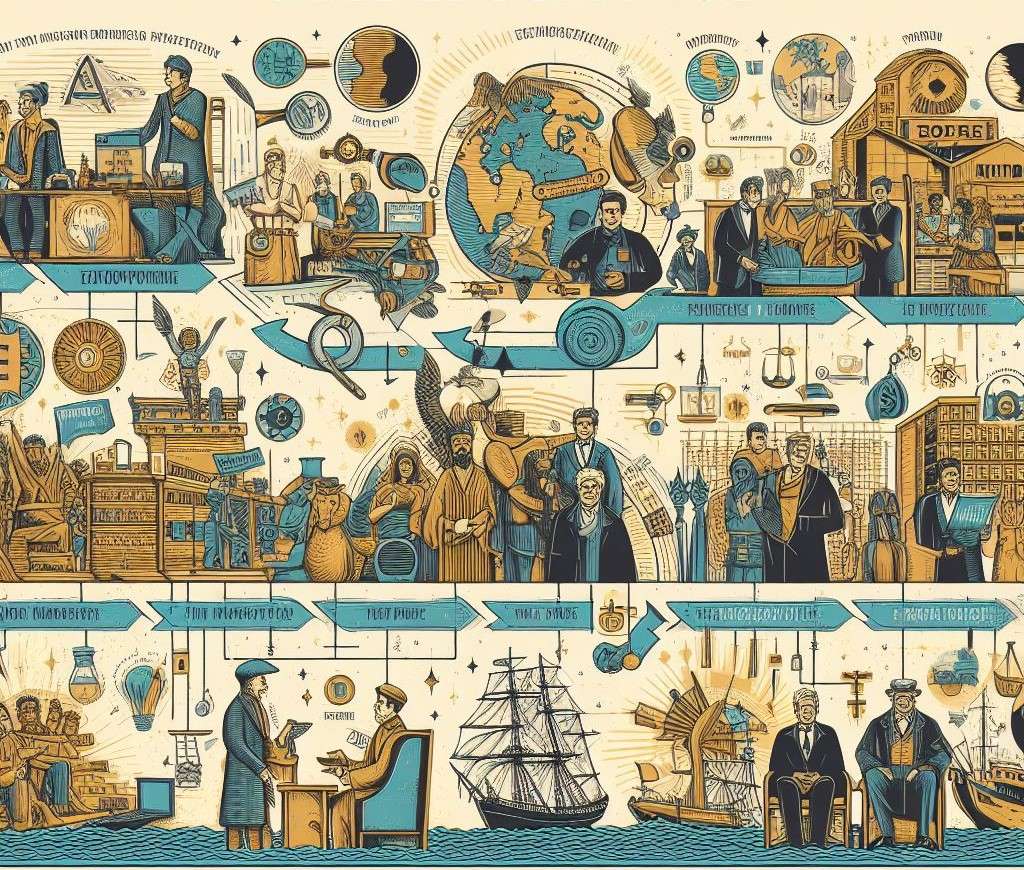In today’s rapidly evolving business landscape, the concept of free enterprise remains as relevant and impactful as ever. It is a driving force that not only shapes economies but also impacts the lives of countless individuals. In this article, we will delve deep into the world of free enterprise, exploring its history, principles, and its profound effects on prosperity and innovation.

Understanding the Foundation of Free Enterprise
The Roots of Free Enterprise
Free enterprise, often synonymous with capitalism, has its roots deeply embedded in history. Its origins can be traced back to the mercantile economies of the 16th century, where merchants and traders engaged in free-market activities. Over time, this economic philosophy evolved into the system we know today.
1. Mercantilism and Its Limitations
Before the advent of free enterprise, the prevailing economic doctrine was mercantilism. Mercantilism was characterized by strict government controls, protectionist policies, and an emphasis on accumulating gold and silver reserves. Under this system, nations believed that the accumulation of wealth was a zero-sum game, where one nation’s gain was another’s loss.
2. Emergence of Market Forces
The transition from mercantilism to free enterprise was driven by a fundamental shift in economic thinking. Economists and philosophers, such as Adam Smith, played a pivotal role in promoting the idea of free markets. Smith’s seminal work, “The Wealth of Nations,” published in 1776, outlined the concept of laissez-faire economics, where market forces, rather than government intervention, should determine prices, supply, and demand.
Key Principles of Free Enterprise
Free enterprise is characterized by several key principles:
1. Private Ownership
Private individuals and entities have the right to own and control property, including businesses. This principle fosters innovation and competition as individuals strive to create unique products and services.
2. Competition
Competition is at the heart of free enterprise. It encourages businesses to constantly improve, innovate, and offer better products and services to consumers. This drive for excellence benefits society as a whole.
3. Minimal Government Intervention (h4)
Free enterprise thrives when governments adopt a hands-off approach to regulating businesses. This allows for market forces to dictate prices, supply, and demand, leading to efficient resource allocation.

The Impact of Free Enterprise on Prosperity
Economic Growth and Job Creation
One of the most significant contributions of free enterprise is its ability to spur economic growth and job creation. In countries where free enterprise is embraced, there is a greater likelihood of robust economic development and a higher standard of living.
The Engines of Growth
Economic growth is powered by a multitude of factors, including:
- Investment: Both public and private investments in infrastructure, education, and technology foster innovation and drive economic expansion.
- Innovation: Technological advancements and innovation are catalysts for growth, as they increase productivity, streamline processes, and create new markets.
- Labor Force: A skilled and motivated workforce is essential for economic progress, as it drives productivity and encourages entrepreneurship.
- Trade: Engaging in international trade opens up new markets, enhances competitiveness, and contributes to economic growth.
- Economic Policies: Sound economic policies, such as fiscal responsibility and monetary stability, provide a conducive environment for growth.
The Transformative Power of Job Creation
Unveiling Job Creation
Job creation is the natural offspring of economic growth. As an economy expands, it generates a demand for labor, resulting in the creation of new employment opportunities. The significance of job creation extends far beyond providing individuals with a source of income; it holds the potential to alter the socio-economic fabric of a society.
Benefits of Job Creation
- Reducing Unemployment: Job creation directly addresses the issue of unemployment, reducing financial stress and enhancing overall well-being.
- Income Distribution: A thriving job market promotes equitable income distribution, narrowing the wealth gap.
- Social Stability: Gainfully employed individuals are more likely to contribute positively to their communities, fostering social cohesion and stability.
Innovation and Technological Advancements
Free enterprise encourages innovation by rewarding creativity and entrepreneurship. Entrepreneurs are more likely to take risks and invest in research and development when they have the potential to reap the rewards of their efforts. This drive for innovation has led to technological advancements that have revolutionized industries.
Technological Advancements: A Catalyst for Change
The rapid pace of technological advancements has ushered in a new era of convenience, efficiency, and connectivity. From the advent of smartphones to the development of artificial intelligence (AI) and the Internet of Things (IoT), these advancements have permeated every aspect of our daily lives.
Smartphones: Our Digital Companions
Smartphones have evolved into indispensable tools, seamlessly integrating into our lives. With the power of a computer in the palm of our hands, we can communicate, navigate, and access information with unparalleled ease. Innovations in mobile technology have not only transformed how we stay connected but have also revolutionized industries like healthcare, finance, and entertainment.
Artificial Intelligence: The Future Unleashed
Artificial intelligence, often referred to as AI, stands as one of the most transformative technological advancements of our time. Machine learning algorithms and neural networks enable computers to analyze vast amounts of data, make predictions, and even learn from their experiences. This has far-reaching implications, from improving medical diagnostics to enhancing autonomous vehicles’ safety.
Internet of Things (IoT): A Connected World
The Internet of Things has interconnected our devices and appliances, creating a web of communication that facilitates automation and convenience. Smart homes, wearable devices, and connected cities are just the beginning of what the IoT promises. This technological advancement is reshaping industries like transportation, agriculture, and energy management.
Wealth Distribution
Critics of free enterprise often point to wealth inequality as a drawback. However, it’s essential to recognize that free enterprise has the potential to lift people out of poverty and create opportunities for social mobility. Policies that promote education and equal access to opportunities can mitigate wealth inequality.
Income Inequality
Income inequality refers to the unequal distribution of income among a population. It is typically measured by income percentiles, with the top earners holding a significant portion of a nation’s income, while those at the bottom struggle to make ends meet. This disparity in income can lead to a wide range of social and economic challenges, including reduced access to education, healthcare, and upward mobility.
Wealth Inequality
Wealth inequality goes beyond income and encompasses the distribution of assets and net worth. It takes into account not only earnings but also property, investments, and other forms of wealth. Wealth inequality is often even more pronounced than income inequality, as it reflects the accumulation of resources over time. This concentration of wealth can perpetuate generational disparities and limit opportunities for economic advancement.

The Role of Free Enterprise in a Globalized World
International Trade and Cooperation
In an interconnected world, free enterprise plays a crucial role in international trade and cooperation. It fosters collaboration between nations, promotes the exchange of goods and services, and contributes to global economic growth.
Economic Growth and Prosperity
International trade, the exchange of goods and services between countries, has been a potent catalyst for economic growth. By allowing nations to specialize in the production of goods and services where they have a comparative advantage, trade enhances efficiency, lowers costs, and expands market access. This results in increased production, higher employment rates, and improved standards of living.
Market Diversification
For businesses, international trade provides an opportunity to diversify their customer base. Relying solely on domestic markets can be limiting, whereas exporting products to international markets can open doors to new customers and revenue streams. This diversification can be a buffer against economic downturns in one’s home market.
Resource Allocation
International trade enables resource allocation on a global scale. Countries can focus on industries that align with their strengths and resources, which can lead to specialization and higher productivity. For example, countries with abundant natural resources may export raw materials, while others with advanced technology may export high-value manufactured goods.
Bilateral and Multilateral Trade Agreements
Countries often form bilateral and multilateral trade agreements to facilitate commerce and reduce trade barriers. Examples include the North American Free Trade Agreement (NAFTA), the European Union (EU), and the Comprehensive and Progressive Agreement for Trans-Pacific Partnership (CPTPP). These agreements streamline trade procedures and promote cooperation among member nations.
Foreign Aid and Development
Developed nations frequently provide foreign aid to support economic development in less developed countries. This form of cooperation can include financial assistance, technical expertise, and infrastructure development. It not only fosters goodwill but also opens new markets for trade.
Public-Private Partnerships
Governments and businesses collaborate through public-private partnerships to address global challenges. For instance, pharmaceutical companies and international organizations may work together to provide vaccines during a global health crisis.
Adaptation to Changing Times
Free enterprise has demonstrated its resilience by adapting to the challenges of a rapidly changing world. It encourages businesses to be agile, responsive, and innovative, ensuring their survival in a competitive global market.
Conclusion: Embracing Free Enterprise for a Prosperous Future
In conclusion, free enterprise remains a powerful engine for economic growth, innovation, and prosperity. Its principles of private ownership, competition, and limited government intervention have proven to be effective in driving progress. While it is not without challenges, its benefits far outweigh its drawbacks. Embracing free enterprise is key to unlocking a path to prosperity for individuals, businesses, and nations alike.
FAQ (Frequently Asked Questions)
Q1: What is free enterprise, and how does it contribute to a prosperous future?
A1: Free enterprise is an economic system that allows individuals and businesses to operate with minimal government intervention. It promotes competition, innovation, and entrepreneurship, which, in turn, stimulate economic growth and prosperity by creating opportunities for wealth creation and job generation.
Q2: How does free enterprise differ from other economic systems?
A2: Free enterprise differs from centrally planned economies (like socialism) because it allows businesses to make their own decisions about what to produce, how to produce, and at what price to sell. It contrasts with a command economy where the government controls most economic activities.
Q3: Is free enterprise the same as capitalism?
A3: While free enterprise and capitalism share similarities, they are not identical. Capitalism refers to the ownership of the means of production by private individuals or corporations. Free enterprise is the broader concept encompassing the idea of minimal government intervention in economic activities within a capitalist system.
Q4: What role does competition play in a free enterprise system?
A4: Competition is a fundamental driver of free enterprise. It compels businesses to offer better products, lower prices, and improved services to attract customers. Healthy competition fosters innovation and efficiency, benefiting consumers and the overall economy.
Q5: Does free enterprise promote income inequality?
A5: Free enterprise can lead to income inequality if not balanced by appropriate policies. However, it also provides opportunities for individuals to improve their economic standing through entrepreneurship, education, and hard work. Many countries implement social safety nets and progressive taxation to address income disparities.
Q6: Can free enterprise coexist with environmental sustainability?
A6: Yes, free enterprise can coexist with environmental sustainability. Businesses can innovate to reduce their environmental impact, and consumer demand for sustainable products can drive change. Some argue that market mechanisms can be more efficient than government regulations in addressing environmental concerns.
Q7: Does free enterprise require government regulation?
A7: While free enterprise thrives with limited government intervention, some level of regulation is often necessary to ensure fair competition, protect consumers, and prevent abuses. The challenge lies in finding the right balance between regulation and free-market principles.
Q8: How does free enterprise impact technological advancements?
A8: Free enterprise encourages technological advancements by fostering an environment where businesses are motivated to invest in research and development to gain a competitive edge. This results in innovations that benefit society and drive economic growth.
Q9: Can free enterprise address social issues such as poverty and inequality?
A9: Free enterprise alone may not solve all social issues, but it can be a powerful tool for economic development. Policies that combine free enterprise with targeted social programs and education can help address poverty and reduce inequality.
Q10: What’s the outlook for free enterprise in the future?
A10: The future of free enterprise will depend on how it adapts to evolving economic, social, and environmental challenges. It is likely to continue playing a vital role in fostering economic prosperity, provided that it remains responsive to the changing needs of society and the planet.

